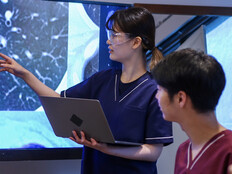EDUCAUSE 2010: The Buzz
Energy management, desktop virtualization and tools for the 21st Century classroom were top of mind when EDUCAUSE 2010 opened last night at the Anaheim Convention Center in Orange County, Calif.
The trade show for college and university IT managers, which runs through Friday, is expected to draw close to 7,000 attendees this week. The EDUCAUSE show opened officially with a reception in the exhibit hall, where more than 260 companies are showing products that aim to make colleges and universities more efficient.
One such product is the Portege R700 notebook from Toshiba. Priced less than $1,000 the notebook features an energy-efficient design that allows it to run faster processors, all in a unit that weighs 3.2 pounds.
Bill Monroe, a national sales training manager at Toshiba, offers two reasons why the R700 can run up to an Intel i7 processor. First, the unit's magnesium alloy chassis is stronger and carries less weight than plastic. And second, the main components, including the CPU and the graphics card on the motherboard, are all located in the same general area in the back of the machine. This makes for more efficient energy management, Monroe says.
Typically, to compensate for overheating, smaller notebooks have to use slower chips, he says. But with the R700's forced-air cooling in the back of the machine, we can use faster processors, so you get portability without sacrificing performance.
The R700 comes with a 500 gigabyte hard drive and three USB drives, with one of the drives offering an option for an eSATA connection.
Energy management is also a major theme at Crestron, which works closely with many campuses to install systems that control and manage computers, projectors, audio and lighting inside classrooms. Crestron's flagship control product is RoomView.
For this year's EDUCAUSE, Crestron is showing LiveView, software layered over RoomView to help colleges track energy management.
Where RoomView lets IT managers monitor the devices on their network, LiveView makes it possible to monitor energy usage, says Cheryl Krasho, a regional manager for education market development at Crestron. The LiveView software can tie into building management, campus lighting and renewable energy sources like solar panels.
Portability Rules
Convenience and portability at an affordable price are on display at Epson, which offers ultra-portable projectors ranging in price from less than $600 to slightly more than $1,000.
Sean Gunduz, a product manager for corporate and higher education projectors at Epson, says although some colleges are far along in installing technology in classrooms, many professors note that classrooms often lack have wall-mounted projectors.
These units are perfect for professors on the go, Gunduz says. They can take them anywhere to just about any kind of setting.
The ultra-portables also have wireless capabilities, USB connectivity and inputs for HDMI and a DVD player. The units also have the Epson Screen Fix feature, which lets a user adjust a crooked horizontal or vertical image to make a perfect rectangle. Another feature is AV Mute, which lets a user mute both the audio and video without having to shut the projector down.
Thin: Still In
Combining thin clients with desktop virtualization was a focus at IBM, which is featuring its IBM Smart Business Desktop Cloud.
Ric Thomann, an alliance sales manager at IBM, explains that in a partnership with Wyse Technology, IBM deploys Wyse thin clients at colleges seeking to deliver centrally managed applications to university administrators and staff.
IBM xSeries servers handle the back-end processing. Each college IT manager gives IBM a golden image of applications they want to run, and IBM uses Wyse Streaming Manager to deliver the apps to thin-client machines.
Colleges find there are many benefits to running thin clients with desktop virtualization, Thomann says, pointing out that thin clients are more secure and less expensive to maintain than PCs.
Because all the data goes to a central server, the data can't be stolen, he says.








